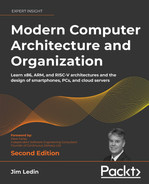A no-nonsense, practical guide to current and future processor and computer architectures that enables you to design computer systems and develop better software applications across a variety of domains Are you a software developer, systems designer, or computer architecture student looking for a methodical introduction to digital device architectures, but are overwhelmed by the complexity of modern systems? This step-by-step guide will teach you how modern computer systems work with the help of practical examples and exercises. You'll gain insights into the internal behavior of processors down to the circuit level and will understand how the hardware executes code developed in high-level languages. This book will teach you the fundamentals of computer systems including transistors, logic gates, sequential logic, and instruction pipelines. You will learn details of modern processor architectures and instruction sets including x86, x64, ARM, and RISC-V. You will see how to implement a RISC-V processor in a low-cost FPGA board and write a quantum computing program and run it on an actual quantum computer. This edition has been updated to cover the architecture and design principles underlying the important domains of cybersecurity, blockchain and bitcoin mining, and self-driving vehicles. By the end of this book, you will have a thorough understanding of modern processors and computer architecture and the future directions these technologies are likely to take. This book is for software developers, computer engineering students, system designers, reverse engineers, and anyone looking to understand the architecture and design principles underlying modern computer systems: ranging from tiny, embedded devices to warehouse-size cloud server farms. A general understanding of computer processors is helpful but not required.Key Features
Book Description
What you will learn
Who this book is for
Table of Contents
- Preface
- Introducing Computer Architecture
- Digital Logic
- Processor Elements
- Computer System Components
- Hardware-Software Interface
- Specialized Computing Domains
- Processor and Memory Architectures
- Performance-Enhancing Techniques
- Specialized Processor Extensions
- Modern Processor Architectures and Instruction Sets
- The RISC-V Architecture and Instruction Set
- Processor Virtualization
- Domain-Specific Computer Architectures
- Cybersecurity and Confidential Computing Architectures
- Blockchain and Bitcoin Mining Architectures
- Self-Driving Vehicle Architectures
- Quantum Computing and Other Future Directions in Computer Architectures
- Appendix
- Other Books You May Enjoy
- Index
